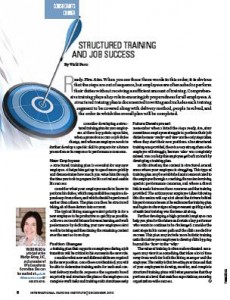Ready. Fire. Aim. When you see these three words in this order, it is obvious that the steps are out of sequence, but employees are often asked to perform their duties without receiving a sufficient amount of training. Comprehensive training plays a key role in ensuring job preparedness for all employees. A structured training plan is documented in writing and includes each training segment to be covered along with delivery method, people involved, and the order in which the overall plan will be completed.
Consider developing a structured training plan for your employees at three key points: upon hire, when a promotion occurs or job duties change, and when an employee needs to further develop a specific skill to prepare for a future promotion or in response to performance concerns.
New Employees
A structured training plan is essential for any new employee. It helps him get up to speed more quickly and demonstrates how much you value him through the time you took to prepare for his arrival and enable his success.
Consider what your employee needs to know to perform his duties, which responsibilities require a dependency from others, and which should be performed earlier than others. The plan can then be structured taking all of these factors into account.
The typical hiring manager’s first priority is for a new employee to be productive as quickly as possible. Achieve a successful balance between learning and work performance by dedicating your new employee’s first week to training and then timing the remaining content over the next 60 to 90 days.
Position Changes
A training plan that supports an employee during a job transition will be critical to his success in the new role.
Consider what new and different skills are required in the new position. Once these are identified, you will be able to determine training units for each and content delivery methods. Sequence the segments based on priority and structure the plan so the employee can complete work tasks and training units simultaneously.
Future Development
Remember when I listed the steps ready, fire, aim? Sometimes employees struggle to perform their job duties because “ready” and “fire” are the only steps taken when they start their new positions. If no structured training was provided, there is a very strong chance the employee will struggle, because “aim” was completely missed. You can help this employee get back on track by developing a training plan.
In this situation, the content is structured around areas where your employee is struggling. This type of training plan may be established and communicated to the employee through a coaching discussion involving specific performance concerns, and where a direct link is made between these concerns and the training provided. The actions your employee takes following this discussion will say a lot about the drivers behind his performance issues. If he embraces the training plan and begins to show signs of improvement quickly, a lack of sufficient training was the issue all along.
Further developing a high-potential employee can help you plan for the future and retain a key performer who wants to continue to be challenged. Consider the next steps in his career path and the skills needed for success. This plan may include more holistic training units that allow your employee to develop skills by going beyond the “how” to the “why.”
The value of training is often underestimated. Managers may view it as something that takes a lot of time away from work for both the hiring manager and the employee. The reality is that investing your time and that of your employees to develop, monitor, and complete structured training plans will better guarantee that they perform at a level that matches expectations, ensuring organization-wide success.
Vicki Pero is principal at the Marilyn Group, LLC, and a member of IPI’s Consultants Committee. She can be reached at vpero@whatsnextco.com or 800.825.6310.
TPP-2012-12-Structured Training and Job Success

